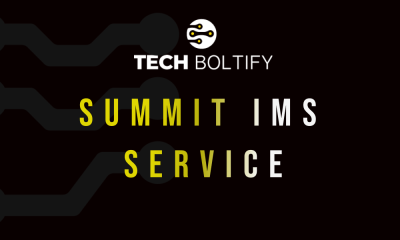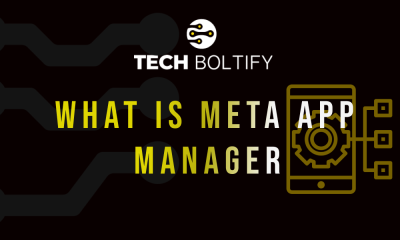Tech
The Role of Live Streaming in E-commerce and Digital Marketing
Live streaming has revolutionized the way businesses connect with their audiences. What started as a feature for gamers and social media influencers has now become an essential tool for e-commerce and digital marketing. Platforms like YouTube Live, Instagram Live, and TikTok Live allow brands to engage with potential buyers in real-time, creating a more personal and interactive shopping experience.
The reason for its success is simple—people crave authenticity. Unlike pre-recorded videos, live streaming feels raw and unscripted, making it more relatable. Consumers trust brands that show transparency, and live streaming provides just that. As competition in e-commerce grows, live streaming helps brands stand out and build stronger connections with their audience.
How Live Streaming Transforms E-Commerce and Digital Marketing
One of the biggest advantages of live streaming is its ability to facilitate real-time engagement. Businesses can showcase their products, answer customer questions, and even offer exclusive deals during the stream. This interactive approach builds trust and encourages impulsive purchases. Many e-commerce platforms have recognized this opportunity and now provide integrated live shopping features. Platforms like Instagram, TikTok, and Amazon Live allow viewers to purchase products directly while watching a live session, making the process seamless.
Beyond direct sales, live streaming also enhances brand visibility. The more interactive and engaging a live session is, the more likely it is to be shared across social media, expanding reach.
The Importance of High-Quality Live Streaming Content
The success of a live stream is heavily dependent on its quality. A blurry or lagging video can turn viewers away within seconds. To maintain professionalism and keep the audience engaged, businesses need to invest in the right equipment and ensure their streams are visually and audibly clear.
One of the main factors affecting quality is resolution. There are two main resolutions: SD and HD. When comparing SD vs HD, you must know that Standard Definition (SD) content may appear pixelated, especially on larger screens, making it difficult for viewers to see product details. High Definition (HD) is the minimum requirement for a professional-looking stream, offering sharp visuals and a more immersive experience. Some brands even opt for 4K streaming to provide the highest level of detail, but this requires a strong internet connection and advanced equipment.
A strong and stable internet connection is crucial for preventing lags and buffering. Interruptions can be frustrating and may cause viewers to leave before the stream ends. Testing the internet speed before going live and using a wired connection instead of Wi-Fi can help avoid these issues.
The Psychology Behind Live Shopping: Why It Works
Live shopping isn’t just about showing products in real-time—it taps into fundamental psychological triggers that drive consumer behavior. One of the strongest factors at play is the fear of missing out, commonly known as FOMO. When brands offer limited-time deals or exclusive discounts during a live stream, viewers feel pressured to act quickly before the opportunity disappears. This creates a sense of urgency, leading to higher conversion rates.
Another psychological trigger is trust. Seeing a product demonstrated live, without edits or enhancements, provides an unfiltered view of what it actually looks like. Consumers are more likely to trust what they see in a live stream compared to traditional advertisements or staged product photos. This transparency helps reduce hesitation and increases confidence in purchasing decisions.
Social proof also plays a big role. When viewers see others participating in a live stream, asking questions, and making purchases, they are more likely to follow suit. The presence of an active audience reinforces the idea that the product is in demand and worth buying.
Choosing the Right Platforms for Live Streaming
Not all live-streaming platforms offer the same benefits. Each has a unique audience and format, so choosing the right platform is crucial for maximizing reach and engagement.
Instagram Live is highly effective for brands targeting younger audiences. Since Instagram is a visual platform, it works well for fashion, beauty, and lifestyle brands. The ability to go live with influencers or collaborators also enhances engagement.
Facebook Live is ideal for brands with a more diverse audience. It works well for longer, in-depth live sessions, such as product demonstrations, interviews, or educational content.
TikTok Live is great for short, interactive sessions. Since TikTok users are accustomed to fast-paced content, brands need to keep streams engaging and dynamic.
YouTube Live is the best option for long-form content. It’s ideal for product launches, tutorials, and behind-the-scenes footage. Since YouTube videos remain available after the live session ends, brands can continue gaining views even after the event is over.
Live Streaming as a Tool for Brand Storytelling
Storytelling is a fundamental part of marketing, and live streaming offers brands a unique way to tell their story in an unscripted and authentic manner. Unlike traditional ads that focus solely on selling a product, live storytelling allows brands to build emotional connections with their audience.
One way businesses use live streaming for storytelling is by sharing behind-the-scenes content. Viewers love seeing the people behind the brand, whether it’s the product design process, warehouse operations, or a day in the life of the founder. This humanizes the brand and makes it more relatable.
Another effective storytelling approach is through customer testimonials. Inviting satisfied customers to share their experiences live creates trust and social proof. Prospective buyers who hear real people talk about their positive experiences are more likely to feel confident in making a purchase.
Metrics That Matter: Measuring Live Streaming Success
To determine the effectiveness of a live stream, brands need to track key performance metrics. These insights help refine future strategies and improve engagement rates.
Viewer count is a fundamental metric that indicates how many people tuned in. A higher number means greater reach, but brands should also analyze peak viewership times to understand when their audience is most active.
Engagement rate is another important indicator. Comments, likes, shares and real-time interactions show how involved the audience was during the stream. High engagement suggests that the content resonated well with viewers.
Conversion rate is the ultimate measure of success for e-commerce live streaming. If the goal is to drive sales, tracking how many viewers made a purchase during or after the live session is essential. Brands often use special discount codes or track click-through rates to measure direct conversions.
Watch time matters because it shows how long viewers stayed engaged. By regularly analyzing these metrics, businesses can identify what works and adjust their live-streaming strategy for better results in future sessions.
Live streaming has redefined digital marketing and e-commerce by offering real-time engagement, building trust, and creating a sense of urgency that drives sales. By choosing the right platform, analyzing key metrics, and staying ahead of trends, brands can continue to leverage live video content to connect with their audience in a more meaningful and interactive way. As consumer expectations evolve, live streaming will remain at the forefront of digital marketing, shaping the future of e-commerce and online engagement.
Tech
How To Bridge Front-End Design And Backend Functionality With Smarter API Strategy
Introduction: Building More Than Just Screens
We’ve all seen apps that look sharp but crumble the moment users push beyond the basics. A flawless interface without strong connections underneath is like a bridge built for looks but not for weight. That’s why APIs sit at the heart of modern software. They don’t just move data; they set the rules for how design and logic cooperate. When APIs are clear, tested, and secure, the front-end feels smooth, and the backend stays reliable.
The reality is that designing those connections isn’t just “coding.” It’s product thinking. Developers have to consider user flows, performance, and future scale. It’s about more than endpoints; it’s about creating a system that’s flexible yet stable. That mindset also means knowing when to bring in a full-stack team that already has the tools, patterns, and experience to move fast without cutting corners.
Here’s where you should check Uruit’s website. By focusing on robust API strategy and integration, teams gain the edge to deliver features user’s trust. In this article, we’ll unpack how to think like a product engineer, why APIs are the real bridge between design and functionality, and when it makes sense to call in expert support for secure, scalable development.
How To Define An API Strategy That Supports Product Goals
You need an API plan tied to what the product must do. Start with user journeys and map data needs. Keep endpoints small and predictable. Use versioning from day one so changes don’t break clients. Document behavior clearly and keep examples short. Design for errors — clients will expect consistent messages and codes. Build simple contracts that both front-end and backend teams agree on. Run small integration tests that mimic real flows, not just happy paths. Automate tests and include them in CI. Keep latency in mind; slow APIs kill UX. Think about security early: auth, rate limits, and input checks. Monitor the API in production and set alerts for key failures. Iterate the API based on real use, not guesses. Keep backward compatibility where possible. Make the API easy to mock for front-end developers. Celebrate small wins when a new endpoint behaves as promised.
- Map user journeys to API endpoints.
- Use semantic versioning for breaking changes.
- Provide simple, copy-paste examples for developers.
- Automate integration tests in CI.
- Monitor response times and error rates.
What To Do When Front-End and Backend Teams Don’t Speak the Same Language
It happens. Designers think in pixels, engineers think in data. Your job is to make a shared language. Start by writing small API contracts in plain text. Run a short workshop to align on fields, types, and error handling. Give front-end teams mocked endpoints to work against while the backend is built. Use contract tests to ensure the real API matches the mock. Keep communication frequent and focused — short syncs beat long meetings. Share acceptance criteria for features in user-story form. Track integration issues in a single list so nothing gets lost. If you find repeated mismatches, freeze the contract and iterate carefully. Teach both teams basic testing so they can verify work quickly. Keep the feedback loop tight and friendly; blame only the problem, not people.
- Create plain-language API contracts.
- Provide mocked endpoints for front-end use.
- Contract tests between teams.
- Hold short, recurring integration syncs.
- Keep a single backlog for integration bugs.
Why You Should Think Like a Product Engineer, Not Just A Coder
Thinking like a product engineer changes priorities. You care about outcomes: conversion, help clicks, retention. That shifts API choices — you favor reliability and clear errors over fancy features. You design endpoints for real flows, not theoretical ones. You measure impact: did a change reduce load time or drop errors? You plan rollouts that let you test with a small cohort first. You treat security, observability, and recoverability as product features. You ask hard questions: what happens if this service fails? How will the UI show partial data? You choose trade-offs that help users, not just satisfy a design spec. That mindset also tells you when to hire outside help: when speed, scale, or compliance exceeds your team’s current reach. A partner can bring patterns, reusable components, and a proven process to get you shipping faster with less risk.
- Prioritize outcomes over features.
- Measure the user impact of API changes.
- Treat observability and recovery as product features.
- Plan gradual rollouts and feature flags.
- Know when to add external expertise.
How We Help and What to Do Next
We stand with teams that want fewer surprises and faster launches. We help define API strategy, write clear contracts, and build secure, testable endpoints that front-end teams can rely on. We also mentor teams to run their own contract tests and monitoring. If you want a quick start, map one critical user flow, and we’ll help you design the API contract for it. If you prefer to scale, we can join as an extended team and help ship several flows in parallel. We stick to plain language, measurable goals, and steady progress.
- Pick one key user flow to stabilize first.
- Create a minimal API contract and mock it.
- Add contract tests and CI guards.
- Monitor once live and iterate weekly.
- Consider partnering for larger-scale or compliance needs.
Ready To Move Forward?
We’re ready to work with you to make design and engineering speak the same language. Let’s focus on one flow, make it reliable, and then expand. You’ll get fewer regressions, faster sprints, and happier users. If you want to reduce risk and ship with confidence, reach out, and we’ll map the first steps together.
Tech
Which SEO Services Are Actually Worth Outsourcing? Let’s Talk Real-World Wins
Okay, raise your hand if you thought SEO just meant stuffing keywords into blog posts and calling it a day. (Don’t worry, we’ve all been there.) Running a business comes with enough hats already, and when it comes to digital stuff, there’s only so much you can do on your own before your brain starts melting. The world of SEO moves quick, gets technical fast, and—honestly—a lot of it’s best left to the pros. Not everything, but definitely more than people expect. So, let’s go through a few of those SEO services you might want to hand off if you’re looking to get found by the right folks, minus the headaches.
Technical SEO—More Than Just Fancy Talk
If you’ve ever seen a message saying your website’s “not secure” or it takes ages to load, yeah, that’s technical SEO waving a big red flag. This stuff lives under the hood: page speed, mobile-friendliness, fixing broken links, and getting those little schema markup things in place so search engines understand what the heck your pages are about.
You could spend hours (days) learning this on YouTube or DIY blogs, but hiring a specialist—someone who does this all day—saves you a load of stress and guesswork. Sites like Search Engine Journal dig into why outsourcing makes sense, and honestly, after one too many late-night plugin disasters, I’m convinced.
Content Writing and On-Page Optimization (Because Words Matter)
Let’s not dance around it: great content still rules. But search-friendly content is a different beast. It needs to hit the right length, work in keywords naturally, answer genuine questions, and actually keep visitors hooked. Outsourcing writing, especially to someone who actually cares about your brand’s tone, is worth it for most of us.
On-page SEO, which is tweaking all those little details like titles, descriptions, internal links, and image alt text, is a time-eater. It’s simple once you get the hang of it, but when you’re trying to grow, outsourcing makes the most sense.
Link Building—Trickier Than It Looks
Here’s where things get a bit spicy. Backlinks are essential, but earning good ones (not spammy or shady stuff) takes relationship-building, tons of outreach, and real patience. You can spend all month sending emails hoping someone will give your guide a shout-out, or you can just hire folks with connections and a process. Just watch out for anyone promising “hundreds of links for dirt cheap”—that’s usually a shortcut to trouble.
Local SEO—Getting Seen in Your Own Backyard
Ever tried showing up for “pizza near me” only to find yourself on page 7? Local SEO isn’t magic, but it takes a special touch: optimizing your Google Business Profile, gathering reviews, and making sure your info matches everywhere. It’s honestly a job in itself, and most small teams find it way easier to have a local SEO pro jump in a few hours a month.
Reporting and Analytics—Don’t Go Blind
Last, don’t skip out on real reporting. If nobody’s tracking what’s working—and what’s not—you’re just flying blind. Outsourced SEO pros come armed with tools and real insights, so you can see if your money’s going somewhere or just swirling down the drain.
Wrapping Up—Be Realistic, Outsource Smarter
You’re good at what you do, but SEO is more like ten jobs rolled into one. Outsource the parts that zap your time or make your brain itch, and keep what you enjoy. Focus on the wins (more leads, higher rankings, fewer headaches), and watch your business get the attention it deserves.
Tech
White-Label SEO: Building Scalable Digital Marketing Partnerships
Table of Contents
- What Is White-Label SEO?
- Why Digital Agencies Choose White-Label Solutions
- How White-Label SEO Works in Practice
- Benefits for Small and Mid-Sized Agencies
- Risk Management and Quality Assurance
- White-Label SEO and Client Retention
- What to Look for in a White-Label SEO Partner
- Future Trends in White-Label SEO
What Is White-Label SEO?
White-label SEO refers to a business arrangement where an agency partners with a third-party provider to deliver SEO services under the agency’s own brand. Unlike traditional outsourcing, where the client may be aware of third-party involvement, white-label models ensure the service provider remains invisible to the end client. The agency retains control over client communication and branding while benefiting from the expertise and tools of seasoned SEO professionals.
This structure allows agencies to offer complete SEO solutions without needing deep in-house expertise, staffing, or technology. For those looking to deliver robust results while maintaining their branding, leveraging an established provider such as SEO white label by Vazoola is a popular route. As demand for scalable and specialized SEO services grows, white-label partnerships have become a cornerstone for forward-thinking digital marketing agencies.
Why Digital Agencies Choose White-Label Solutions
Agencies of all sizes frequently encounter resource constraints, particularly as clients ask for increasingly sophisticated services. Building an advanced SEO department in-house can be cost-prohibitive, requiring hiring, training, and constant adaptation to search engine algorithm changes. White-label solutions are attractive because they enable agencies to offer first-rate SEO without prohibitive investments.
Additionally, as the digital landscape evolves, clients seek integrated digital marketing strategies instead of disconnected services. With white-label SEO, agencies can rapidly expand their offerings, supporting their growth strategies while capturing a larger market share. This flexibility allows consultancies and digital agencies to remain competitive as demands for comprehensive solutions intensify.

How White-Label SEO Works in Practice
A typical white-label SEO partnership starts with thorough onboarding and aligning goals and processes between the agency and the provider. The agency submits client data and campaign objectives, while the provider crafts a tailored SEO strategy and implementation plan. Once campaigns are underway, the agency oversees communication with its clients, while the provider handles the technical execution—keyword research, link building, technical audits, or content creation.
White-label SEO providers support streamlined communication through client dashboards, branded reports, and regular performance updates. Consistent reporting helps agencies build trust and credibility with their clients without revealing the third-party provider. Workflow automation and transparency are central to success, as illustrated in case studies where agencies have seamlessly scaled from a handful to dozens of clients due to repeatable, managed processes. For further insights, consider Moz’s SEO Guide, a comprehensive resource on industry-accepted best practices.
Benefits for Small and Mid-Sized Agencies
White-label SEO is often a game-changer for small and mid-sized agencies because it equalizes the playing field with larger competitors. These agencies can deliver enterprise-grade SEO services by tapping into top-tier talent and technology while maintaining personalized client relationships. This versatility helps attract and retain clients who might otherwise gravitate toward major digital marketing firms.
Another key advantage is the ability to focus internal teams on their strengths, whether that’s account management, creative work, or strategy. Rather than spreading resources thin, agencies can direct their energy where it adds the most value. By outsourcing technical SEO, they reduce overhead and avoid the risks of hiring, training, and turnover.
Risk Management and Quality Assurance
A significant challenge in white-label SEO is ensuring consistent communication, maintaining transparency, and delivering dependable results. Agencies should adopt robust QA frameworks to monitor campaign progress, verify deliverables, and address issues promptly. Scheduled performance reviews, auditing tools, and transparent project management processes are essential to quality assurance.
To mitigate risks, agencies should establish transparent reporting systems and agree on milestones and metrics upfront. Following the guidance of established leaders like Moz can help agencies set clear expectations and implement best practices in all aspects of SEO campaign delivery.
White-Label SEO and Client Retention
Strong white-label partnerships foster long-term client retention. Agencies can consistently deliver value through outcome-focused campaigns—whether improving rankings, increasing organic traffic, or driving conversions. The ability to tap into a partner’s expertise and resources means agencies are better equipped to meet evolving client expectations and deliver measurable results over time.
The seamless integration of white-label services also allows agencies to provide end-to-end digital marketing solutions, reducing the need for clients to seek alternative providers.
What to Look for in a White-Label SEO Partner
Choosing the right white-label SEO partner is crucial. Agencies should prioritize experience, reputation, transparent processes, and technical scalability. A strong partner openly shares methodologies, provides real-time support, and can accommodate a growing client base without sacrificing quality or compliance.
Be wary of partners who promise rapid results without clear strategies, offer generic services, or lack documented reporting and quality control processes. Key questions to ask include: What is your approach to link building? How do you handle reporting and communication? What QA measures are in place? Review insights from trusted white-label news sources to compare industry-leading providers and inform your vetting process.
Future Trends in White-Label SEO
Automation, AI integration, and advanced analytics define the future of white-label SEO. Emerging tech platforms help streamline keyword research, content optimization, and reporting, delivering greater efficiency for agencies and their clients. As client expectations rise, providers focus on more sophisticated dashboards, granular analytics, and proactive strategic support.
Similarly, the partnership model is evolving. Agencies and white-label providers are moving toward deeper collaborations, with joint innovation and tailored solutions playing an increasing role. Agencies prioritizing adaptability and choosing forward-thinking partners will be best positioned to thrive in the changing landscape.
-
Tech1 year ago
AI and Freight Management
-

 Tech1 year ago
Tech1 year agoLPPe Service Android App and its Functions – How to Remove it
-

 Tech1 year ago
Tech1 year agoWhat is a Permission Controller – Control Manager Notifications
-

 Tech2 years ago
Tech2 years agoWhat is Device Keystring App On Android
-

 Tech2 years ago
Tech2 years agoWhat is Carrier Hub – How to Resolve Processing Requests Issues
-

 Tech1 year ago
Tech1 year agoWhat is Summit IMS Service – How to Stop Syncing on Your Android Device
-

 Tech1 year ago
Tech1 year agoMeta App Manager – What is Meta App Installer
-

 Tech1 year ago
Tech1 year agoWhat is Cameralyzer Samsung – How to Fix or Uninstall Cameralyzer on Android

